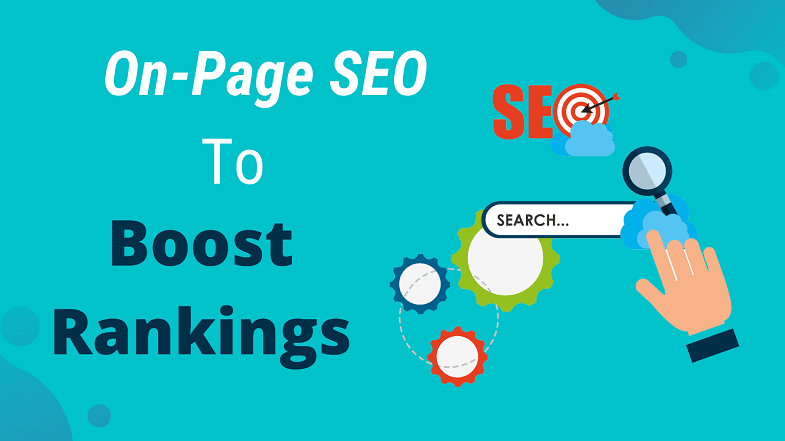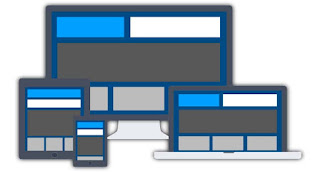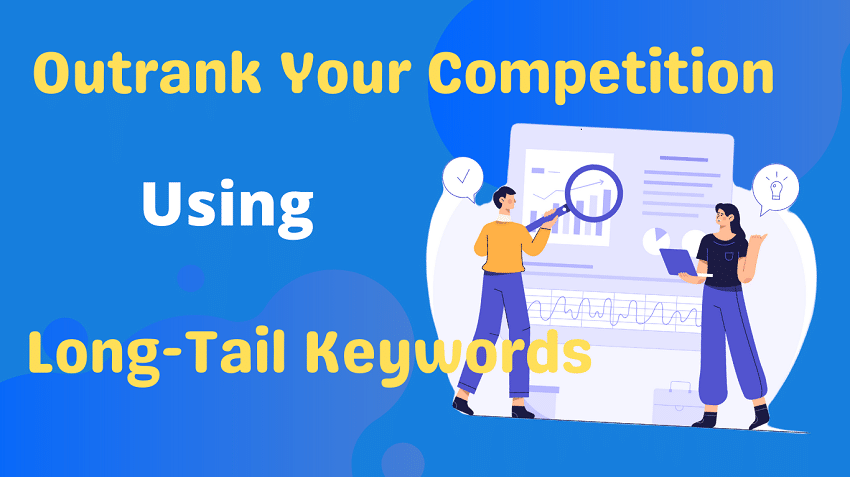
On-page SEO is the technique of optimizing your web design and content for search engines as well as obtaining a better user experience on your blog.
Although, it is one of the most important factors which search engines take charge of while ranking your website.
Nowadays, most bloggers keep more focus on off-page SEO and on-page SEO skips out in the shadow.
This is the biggest mistake blocking your blog from ranking in search results.
Let’s assume that you are somehow able to rank your blog on Google using backlinks or any other off-site SEO tactics.
But, your ranking would be temporary.
As if you haven’t optimized for on-page SEO, the users will bounce back from your site.
And search engines would kick you off from search results, hence reducing your traffic.
So, off-page SEO only performs well if you first focus on your on-site SEO.
Note- On-page SEO is sometimes referred to as on-site SEO.
Table Of Contents
- 13 Best On-Page SEO Techniques
- 1. Content Is King
- 2. Reduce Your Website Loading Time
- 3. Optimize For Search Intent
- 4. Use Responsive Website Design
- 5. Keyword Research For Better Ranking
- 6. Use Headings And Subheadings For Better Post Layout
- 7. Optimize Your Images For SEO
- 8. Write a Compelling Meta Description
- 9. Write Eye-Caching Headlines
- 10. Interlink Your Website Content
- 11. Link To External Sources
- 12. Proofreading Your Content
- 13. Provide Social Sharing Buttons In Blog
- Bonus Tip
- Conclusion
13 Best On-Page SEO Techniques
So, as you know the importance of on-page SEO for your blog, you need to apply proven tips and techniques to get the best results.
In this post, I would share with you the 13 best and proven on-page SEO techniques to rank better on search engines.
This guide would help you to learn how to write a great post optimized for both users as well as search engines.
Let’s dive into it.
1. Content Is King
If you have spent some time blogging, you would be known about a great marketing quote “Content Is King“.
If you want to succeed in the field, your main focus should be on writing quality and informative content.
Writing long-form content has many more benefits also.
According to Hubspot, articles with 2500+ words get the most social shares, as well as they also occupy Google’s first page.
But, you should not write a type of blah-blah in your posts for sake of making them longer.
Long-form content means writing problem-solving and informative content along with images, videos, and infographics.
Writing quality content also helps in positioning yourself as an expert and building your trust among potential users.
2. Reduce Your Website Loading Time
The loading speed of your website is extremely important for both the user experience and the ranking of your blog.
In this fast world, no one is going to wait for you.
On average, 50% of your users will bounce back if your site takes more than 3 seconds to load.
Google as a search engine always tries to optimize the web so that users get the best results.
That’s the reason that Google has officially declared that they use site speed as an important metric in web page rankings.

There are many factors that govern your website loading time like compressing images, minimizing HTTP requests, and more.
So, always try to keep your blog speed lightning fast as
More loading speed means more user engagement and furthermore sales.
3. Optimize For Search Intent
Search intent is the reason behind a user making a query on search engines.
Google always tries to optimize the web by trying to provide better and more exact content that the user wants.
The search intent behind a particular query could be informational, navigational, or transactional.
You need to optimize your content based on the search intent of users so that you rank at the top.
But how to do it the right way?
Let’s assume that you are writing an article about “SEO tips”.
Then search for your topic and see what type of articles are the results showing.
i.e if people want to get full SEO guides or some actionable tips and tricks.
So if you want to rank on SERPs, it’s mandatory to include search intent optimization in your SEO schedule.
4. Use Responsive Website Design

A responsive web design is a design that could fit and optimize for all screens whether computer or mobile and provide a better user experience.
Due to ultimate internet access everywhere, people now surf the web on different devices like phones, tablets, and more.
That’s why optimizing for a responsive theme has become mandatory for both SEO and user experience.
After Google recently announced an algorithm change of mobile-first indexing in 2020,
the websites without a mobile-friendly design, would not survive in search results.
5. Keyword Research For Better Ranking
Keyword research is the most important task before writing a post.
If your posts and content are not backed by keyword research, your blog couldn’t ever rank on SERPs.
So, what is keyword research?
Keyword research means finding words and phrases that your target audience searches for in search engines like Google and Bing.
So, choosing the best keywords could help you a lot.
You can use free tools like Google Keyword Planner and Ubersuggest for finding keywords with low competition and high traffic volume.
But if you want to take your keyword research task to next level, I suggest you use a paid SEO tool like Semrush.
Below are some key points that you need to follow while doing keyword research for the best results
- Choose a broad topic for your content or blog post.
- Then, search for low competition and high traffic keywords related to your broad term.
- Create a list of 6-8 keywords along with long-tail keywords.
- Now find LSI keywords related to your target keywords and try to embed them in your posts. (You can use a tool like LSI Graph for it)
- The last thing is to focus on that you are not doing keyword stuffing and only add keywords in posts wherever they look genuine.
So, this strategy would help you to rank on keywords your target audience is searching for, hence increasing your traffic.
6. Use Headings And Subheadings For Better Post Layout
Using headings and subheadings while writing a blog post helps to make it look clean and well structured.
It also helps users to understand your content better.
As we know, nowadays the attention span of a user is very low.
So, using subheadings in posts helps users to skip out content they don’t want to read on.
Heading tags range from H1 to H6 where H1 is used for the topmost heading and further H2, H3 …. are used to divide content further into parts.
These tags are also useful for your on-page SEO.
Adding your target keywords and related words in subheadings could help search engines better understand your content and rank it.
Note– Don’t unnecessarily dump keywords in headings, only use them wherever it makes sense.
7. Optimize Your Images For SEO
Do you know?
According to social media today, images are returned for 19% of search queries on Google.
So, it makes sense to add compelling and great images to your posts.
Not only that,
Images also help to make your content look attractive and break the text.
But if you are not doing proper image optimization, it could be bad for your blog.
The major impact being is it drastically increases the loading speed of your website.
So you need to check the following things before adding images to your content-
- Choose desired image format like PNG, JPEG, or WEBP. (You can use PNG format when you need more clear images like screenshots and for others, use JPEG format)
- Always compress images before posting them to increase website speed.
- Write a descriptive alt tag for your images so that search engines could understand your images.
- Customize image file names rather than using default file names. (For example: Use a custom image file name that describes what it is about)
- Always use unique and copyright-free images in your posts.
8. Write a Compelling Meta Description
A meta description is an HTML tag that provides a short description of your web page.
According to best practices, you should write a meta description ranging from about 130-160 characters.
Most commonly, Google shows this meta description in the search results under your page title as snippets as in the below image

So, the user first sees your meta description before clicking on your post.
Crafting a clickable and interesting description with your target keywords would help to increase the CTR of the page.
You can also add lines that provoke users’ curiosity to read the post.
9. Write Eye-Caching Headlines
Headlines are an important part of your on-page SEO.
When a user enters a search query, he only gets to see the headline and description of your post.
So, you need to create titles that provoke users’ attention and force them to click on them.
Magnetic titles help to increase the CTR of pages.
However, bad headlines could also make your strategy fail even if you are ranking at top of the search page.
Below are tips that could help you to write powerful and compelling headlines-
- Use numbers in your title like “17 Best Tips”.
- Add power words in headlines like “ultimate”, “best”, “untapped” and more.
- Questionable headlines also capture the visitor’s attention.
- Write a title with a limit of 50-60 characters.
- Try to use odd numbers in your headlines as odd no. attract more people than even numbers.
10. Interlink Your Website Content
Internal links are the links that navigate from one web page to another web page within the same domain.
They are an important part of your on-page SEO.
Internal links help search engines and web spiders to navigate your important pages and crawl your pages well.
Using descriptive and related keywords as anchor text is the best on-page SEO practice while linking your content internally.
Moreover, it makes your posts more informative and reduces bounce rate as users may jump to other posts from internal links.
11. Link To External Sources
External links are an important part of your on-page SEO strategy.
A website to which an external link points to gets a backlink which is an important part of SEO.
External links are also beneficial for your website.
Linking out to trustworthy and valuable web pages helps search engines to know about your page topic more deeply.
It also improves the user experience of your page by making your content more informative and useful.
However, you can also mail the webmasters whom you linked to and let them know about it.
Most of them would like to return you the favor by sharing your posts or linking back to your blog.
12. Proofreading Your Content
Would you like to read a post with grammatical errors and wrong sentences?
Absolutely not.
The users will quickly push the back button if your post is full of spelling errors and mistakes.
This single mistake could let all other strategies fail.
But, I know that making mistakes is human nature, and proofreading your content manually could be a difficult task.
So, here comes the need for a grammar checker and proofreading tool.
By far, Grammarly is the best spell checker and proofreading tool on the web.
And the best thing is that it’s free to use.
You only have to do is to register on Grammarly for free and install an extension.
It would help you to make your content error-free and increase the user-friendliness of your blog.
13. Provide Social Sharing Buttons In Blog

Nowadays, social media sites are becoming a great source of traffic for new websites.
However, social media shares are also indirectly related to the organic ranking of your blog.
But you need to make it easy for your audience to share your content.
So, adding social sharing buttons in your post could help you to get a high number of social shares and drive traffic to your blog.
You can use the Social Snap plugin to create beautiful social sharing and follow buttons.
Adding click-to-tweet boxes within your post could also help in increasing your Twitter shares and engagement.
Also Read–
Bonus Tip
Customizing your permalink structure also helps in improving your on-page SEO.
By default, permalink structures appear as long and unhealthy URLs for SEO.
But, you can customize your permalinks to make it short and descriptive.
Descriptive URLs help both search engines as well as users to know about your page topic.
Here are some tips which you should keep in mind while customizing your permalinks-
- Use a simple permalink structure.
- Make your URL descriptive by adding your target keyword.
- Don’t use stop words in permalink like ‘is’, ‘you’, and ‘to’.
- Keep your URL short.
Conclusion
So, I hope this on-page SEO guide would help you to increase your on-page SEO score.
All the on-page SEO strategies referred to above have been manually tested and provide great results if done correctly.
Blogging is all about creating a unique brand and credibility in front of your audience.
And on-page SEO is an important part of maintaining a well-engaged audience and becoming an authority in the industry.
Please share this post with your friends on social media if you found it useful.
Sharing is Caring
Affiliate Disclosure- This post may contain affiliate links means that if you buy a product or get a subscription by clicking on the link in my blog, I will earn a small commission at no extra cost to you.







Thank you, for all of your helpful articles. I am trying to improve my blog and have found your information useful. I am implementing several of your tips and ideas on my personal blog.
Feeling very happy to hear from you.
I am glad to know that you found my on-page SEO techniques post helpful. Let me know in comments if you have any further doubts
These are actually fantastic ideas in concerning blogging.
You have touched some fastidious points here. Any way keep up wrinting.
Hey, thanks for your feedback.
I am very happy that you liked my post and these comments from you even motivate me to perform better.
Hi this is kinda of off topic but I was wanting to know if blogs use WYSIWYG editors or if you have to manually code with HTML.
I’m starting a blog soon but have no coding knowledge so I wanted to get guidance from someone with experience.
Any help would be enormously appreciated!
We use HTML editor (WordPress) here at our blog. Hope this helps.
An impressive share! I’ve just forwarded this onto
a colleague who had been conducting a little homework on this.
And he actually ordered me dinner because I stumbled upon it for him…
lol. So allow me to reword this…. Thank YOU for the meal!!
But yeah, thanx for spending time to discuss this issue here on your web site.
Glad to know that your friend found it useful.